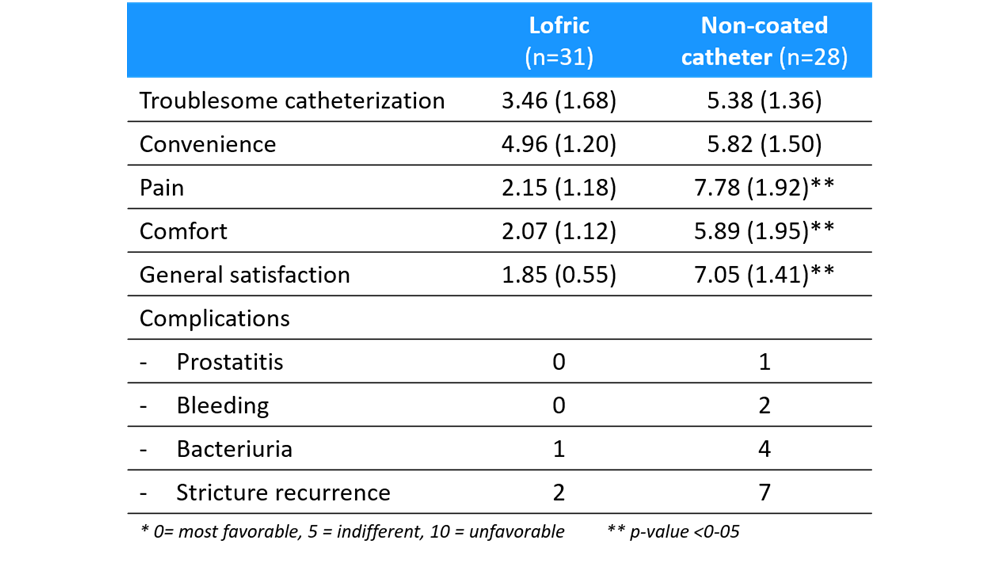
A urethral stricture is an abnormal narrowing of the urethra and is often caused by trauma or inflammation.2 As catheterization is one cause of strictures, non-traumatic catheterization technique and catheter material are essential parts in preventing the occurrence of these complications.3 Common treatment methods for urethral strictures are urethrotomy and intermittent catheterization/dilatation.1 2 4
Urethrotomy is an endoscopic surgical procedure that dilates the urethra, and it is performed in a medical center under local anesthesia. Intermittent catheterization/dilatation can be learned and performed at home. Recurrence rates for strictures are between 40-80%1 but intermittent catheterization/ dilatation has been reported to reduce recurrence.1 4 For example, Elhaj et al. report of lower stricture recurrence rates among patients who practiced intermittent catheterization (77.41% versus 19.35%).4 There is a significant impact on patients’ quality of life when experiencing and treating strictures5 which is why it is important to use treatment alternatives that optimize comfort and reduce pain.
LoFric documentation
- Bladder outflow problems in females.6
Study of 188 females with bladder outflow problems showing an example on LoFric use to successfully treat and prevent recurrent urethral strictures. - Clean Intermittent Catheterization Following Urethral Stricture Surgery Using a Low Friction Catheter Versus Conventional Plastic Catheter: A Prospective, Randomized Trial.1
2 year follow-up on 31 LoFric users and 28 users of non-coated plastic catheters investigating prevention and/or treatment of recurrent strictures after endoscopic urethrotomy.
This randomized controlled study compared the use of LoFric or non-coated catheters for intermittent catheterization treatment of strictures after endoscopic urethrotomy. The study included 62 men, 41 treated for their first stricture and 21 with recurrent problems. All patients had an indwelling catheter placed after surgery and were taught intermittent catheterization 2 weeks later. The patients were followed for 2 years and each patient evaluated their catheter use with a questionnaire. Three patients from the control group failed to follow-up. There were no differences detected between the catheters with regard to convenience or in how troublesome the catheterization was. However, patients found the LoFric catheter to generate less pain (22.6% vs. 64.5% of patients), higher comfort, and better general satisfaction (71% versus 32.2%). The study concluded that the LoFric catheter decreases pain, and increases comfort and satisfaction compared to a non-coated catheter. For this reason, LoFric should be considered as a better option for prevention of urethral strictures from a quality of life aspect.

Table based on results reported in Sallami et al. 20101
"Postoperative intermittent self-dilatation effectively reduces the relative risk of recurrence of a new urethral stricture after internal urethrotomy from 32%...to 8%.7"
- Intermittent self-dilatation after internal urethrotomy for primary urethral strictures: a case-control study.7
Observational study of 55 users of hydrophilic catheters and 162 control patients followed during a 3-6 year period. Results showed evidence of the preventive effects of intermittent self-dilatation (ISD) on stricture recurrence. For example, stricture recurrence was 8% among those who practised ISD with hydrophilic catheters and 32% in the control. The median time to first recurrence was 2 years for the ISD group and 6 months for the control.
"...intermittent low-friction self-catheterization is safe and effective in preventing stricture recurrence in the long term.8"
- Long-term results of intermittent low-friction self-catheterization in patients with recurrent urethral strictures.8
6-36 months study of 101 LoFric-users showing evidence that LoFric is a safe and effective way to prevent stricture recurrence long-term (>12 months).
"Weekly clean intermittent catheterization is a simple method of reducing the frequency of urethral stricture recurrence after internal urethrotomy.9"
- Prevention of urethral stricture recurrence using clean intermittent self-catheterization.9
1-4 year study of 31 LoFric users and 24 control patients that provides evidence for the use of LoFric to effectively reduce the frequency of recurrent urethral strictures. For example, 68% of patients not treated with intermittent catheterization experience recurrent strictures during the first year after urethrotomy compared to 19% in the LoFric-group.
"...for the treatment of recurrent urethral stricture clean intermittent self-catheterization following internal urethrotomy should be continued for a long duration, possibly permanently.10"
- Treatment of recurrent urethral stricture by internal urethrotomy and intermittent self-catheterization: a controlled study of a new therapy.10
12 months follow-up of 23 patients practicing intermittent catheterization with LoFric (refers to abstract by Lawrence et al, 1991 and Zambon et al, 1990 on the use of LoFric) and 28 control patients. The study shows no recurrent strictures in patients who are actively practicing intermittent catheterization in orde to prevent urethral stictures. - Treatment of recurrent urethral strictures using clean intermittent self-catheterisation.11
6-months study of 65 patients with LoFric showing evidence of treating and preventing recurrent urethral strictures. - Treatment of urethral stricture disease by internal urethrotomy followed by intermittent ‘low- friction’ self-catheterization: preliminary communication.12
Preliminary results of Harriss et al. 199492 showing that postoperative urine flow-rates can be maintained if “low-friction” catheterization with LoFric is adopted.